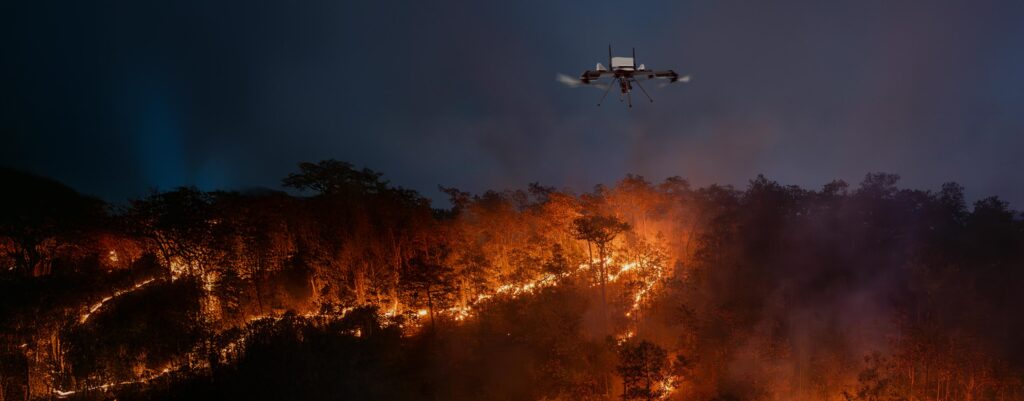
Forest fires are an ongoing global threat to ecosystems, wildlife, and human populations. They can spread quickly, affecting vast landscapes and making traditional firefighting methods less effective. As the frequency and intensity of forest fires have increased globally, particularly in dry regions, the need for innovative solutions has become more critical than ever. Unmanned Aerial Vehicles (UAVs) have emerged as a valuable tool for mitigating forest fires, offering enhanced surveillance, early detection, and cost-effective response strategies.
Global Impact and Future of UAVs in Firefighting
The devastating Camp Fire in Northern California in 2018 is a poignant example of UAVs’ crucial role in response and recovery operations. This incident highlighted the need for improved firefighting techniques. UAVs not only offered real-time mapping of the damaged areas, but they also helped homeowners expedite insurance claims and FEMA assistance, demonstrating their versatility. UAVs are changing how firefighters respond to emergencies by allowing them to analyze topography, track fire movements, and make informed judgments.
Globally, the use of drones in forest fire management has grown significantly. According to the Firefighting Drones Market report by Allied Market Research, the market for firefighting drones is expected to grow at a compound annual growth rate (CAGR) of 10.2% from 2022 to 2031. Advancements in drone technology, such as longer battery life, high-definition cameras and sensors, and AI-powered analytics, drive this surge.
As these technologies evolve, UAVs will play an increasingly important role in fire prevention, real-time monitoring, and disaster recovery efforts, assuring safer and more effective forest fire control.
Benefits of UAVs in Forest Fire Management
- Improved Fire Detection & Response
UAVs with high-resolution thermal cameras can detect flames from far away, enabling ground crews to respond quickly and prevent the fire from spreading to neighboring regions.
- Continuous Surveillance
Unlike traditional monitoring methods, UAVs provide 24/7 surveillance, even in remote or hard-to-reach areas. This capacity ensures that fire-prone areas are constantly monitored, lowering the likelihood of undetected outbreaks.
- Quick Deployment
UAVs are quickly deployed and can survey vast areas swiftly. This reduces the fire department’s reaction time from hours to minutes, allowing them to direct efforts where they are most needed.
- Cost-Effective
Traditional methods of monitoring forest fires, such as helicopters and foot patrols, are costly and resource-intensive. UAVs offer a more cost-effective approach, enabling real-time monitoring with fewer resources.
- Forest Fire Risk Assessment
By analyzing environmental factors such as wind direction, vegetation dryness, and terrain, UAVs help identify high-risk zones. This allows officials to undertake targeted risk-mitigation tactics before a fire breaks out.
How are UAVs used in Firefighting?
- Aerial Surveillance and Situational Awareness
UAVs provide important real-time images and videos during firefighting operations, allowing officials to observe from above. The data from UAVs can help asses the extent, spread, and movement of fires, which is critical in resource deployment, evacuation planning and firefighting strategies.
- Thermal Imaging for Rescue and Firefighting
One of the key advantages of UAVs in firefighting is their thermal imaging capabilities. They can detect hotspots within a fire, revealing areas of tremendous heat that would otherwise go undetected. This technology is particularly beneficial for detecting stranded persons or animals, even when visibility is limited due to smoke or darkness. UAVs help prioritize rescue efforts and improve resource allocation, boosting the odds of saving lives and limiting damage.
- Emergency Communication and Coordination
UAVs equipped with communication devices act as critical relay points in disaster-prone areas or remote locations where traditional communication networks are down. They set up temporary communication networks to keep firefighting teams in contact with one another and the command center. This ensures seamless information flow, improves cross-agency coordination, and enables faster, more effective decision-making.
- Forest Mapping and Encroachment Detection
Beyond emergency response, UAVs are also instrumental in preventive measures. They can detect unlawful activity, such as logging or unauthorized construction, by regularly mapping forests and monitoring protected areas. Detecting these encroachments early allows authorities to take prompt action, avoiding potential fire hazards and protecting the environment from additional damage.
- Post-Fire Assessment and Recovery
UAVs can help with post-fire assessments even after a fire has been extinguished. They can acquire comprehensive aerial photographs of the impacted area, which are then utilized to build 3D models and point cloud maps. These visualizations assist in determining the extent of the damage to buildings, infrastructure, and the environment. The information acquired is useful in insurance claims, post-fire investigations, and recovery planning, helping authorities to better comprehend the damage and plan for reconstruction.
Use Cases of ideaForge’s Q6 UAV in Early Fire Detection and 24/7 Surveillance
Globally, UAVs have proven their worth in diverse settings. In India’s Haliyal Forest, the forest government deployed Q6 V2 UAVs developed by ideaForge for round-the-clock surveillance. With new-age sensors and real-time feeds, UAVs were able to monitor dense forest regions effectively and detect fire hazards early, enabling timely intervention before the fire could spread. This successful application demonstrates the effectiveness of advanced UAV technology in tackling fire-related concerns, especially in areas with dense vegetation and limited access.
Looking Ahead
UAVs are now an integral part of modern firefighting strategies, with their capabilities in rapid detection, continuous surveillance, and cost-effective operation proving invaluable. As the adoption of UAV technology grows, forest fires are expected to be managed more effectively, minimizing their devastating impacts. With advanced tech like thermal imaging and real-time data analysis, UAVs are set to play an even greater role in combating wildfires globally. By offering new-age UAV technology enabled with thermal imaging, real-time monitoring, and broad area coverage, ideaForge is at the forefront of innovation, helping forest departments and firefighting teams to mitigate forest fires effectively with enhanced efficiency and accuracy.

